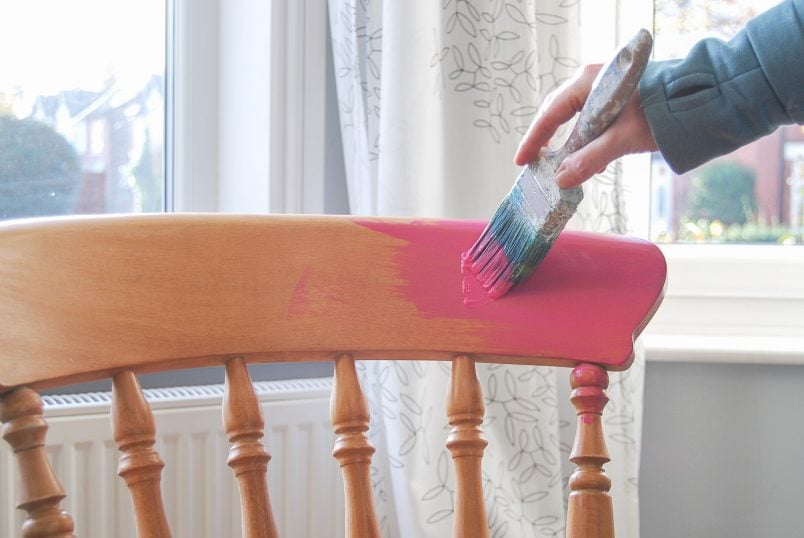Preparing the Chair

A well-prepared chair is crucial for a successful shabby chic makeover. A smooth surface ensures even paint application and a beautiful, long-lasting finish.
Removing Old Paint or Varnish
Removing old paint or varnish is essential for a fresh start. This step helps ensure the new paint adheres properly and prevents unevenness.
- Sanding: For light coats of paint or varnish, sanding is often sufficient. Use fine-grit sandpaper (120-grit or higher) to gently smooth the surface, removing any bumps or imperfections. Work in the direction of the wood grain for a more natural look.
- Chemical Stripper: For stubborn layers of paint or varnish, a chemical stripper is necessary. Apply the stripper according to the manufacturer’s instructions, wearing gloves and eye protection. Allow the stripper to work for the recommended time, then scrape off the softened paint or varnish with a putty knife. Remember to work in a well-ventilated area and avoid contact with skin.
- Heat Gun: A heat gun can be used to soften old paint or varnish, making it easier to scrape off. Be careful not to overheat the wood, as this can cause damage. Direct the heat gun over the surface, moving it constantly to avoid burning. Once the paint or varnish softens, scrape it off with a putty knife.
Cleaning the Chair
Thorough cleaning after removing old paint or varnish is essential to ensure a clean and smooth surface for painting.
- Dust Removal: Use a damp cloth or a vacuum cleaner with a brush attachment to remove dust, dirt, and debris from the chair. Pay special attention to crevices and hard-to-reach areas.
- Grease Removal: If the chair has been exposed to grease or oil, clean it with a degreaser. Apply the degreaser according to the manufacturer’s instructions, then wipe the chair clean with a damp cloth. Allow the chair to dry completely before painting.
Finishing Touches: How To Paint A Wooden Chair Shabby Chic

Now that your chair is painted, it’s time to seal in the beauty and protect it from wear and tear. You’ll also add some final touches to give it that authentic shabby chic charm.
Applying a Clear Sealant
Applying a clear sealant is essential for protecting your chair’s painted surface and enhancing its durability. Here’s a step-by-step guide:
- Choose the Right Sealant: Select a sealant that’s compatible with your paint type. Options include polyurethane, acrylic, or wax. Polyurethane is known for its durability and water resistance, while acrylic is easier to apply and dries quickly. Wax offers a more natural finish.
- Prepare the Surface: Ensure your chair is clean and dust-free. You can use a damp cloth to wipe away any dust or debris. Allow the surface to dry completely before applying the sealant.
- Apply the Sealant: Apply the sealant evenly using a brush, roller, or spray. Follow the manufacturer’s instructions regarding application techniques and drying time.
- Multiple Coats: For added protection, apply multiple thin coats of sealant, allowing each coat to dry completely before applying the next.
- Let it Cure: Allow the sealant to cure completely according to the manufacturer’s instructions. This ensures it reaches its full strength and provides optimal protection.
Decorative Elements, How to paint a wooden chair shabby chic
Decorative elements can enhance your chair’s shabby chic style and add a personal touch.
- Stencils: Use stencils to create intricate patterns or designs on the chair’s surface. Choose patterns that complement the overall style, such as floral motifs, vintage lettering, or geometric designs.
- Fabric: Cover the chair’s seat or back with fabric that complements the shabby chic theme. Consider using patterned fabrics with floral designs, lace, or linen textures.
- Hardware: Replace existing hardware with decorative elements like antique-looking knobs, pulls, or hinges. These details can add a touch of vintage charm and enhance the chair’s visual appeal.
Creating a Distressed Effect
A distressed effect is a hallmark of shabby chic style, giving the chair a vintage and worn look.
- Sandpaper: Use sandpaper with varying grits to create a distressed effect. Start with a coarse grit to remove paint in specific areas, creating a weathered appearance. Then, use finer grits to smooth out the edges and achieve a more subtle effect.
- Wax: Apply a layer of clear wax to the entire chair. Then, use a cloth or sandpaper to rub away the wax in specific areas, revealing the underlying paint and creating a distressed look.
- Other Techniques: Experiment with other techniques to achieve a distressed effect. You can use a wire brush to create scratches, a hammer to create dents, or a paint scraper to remove paint in specific areas. Remember to be cautious and use these techniques sparingly to avoid damaging the chair.
How to paint a wooden chair shabby chic – The charm of shabby chic lies in its imperfections, so don’t be afraid to embrace the natural wear and tear of your wooden chair. A gentle sanding and a few coats of distressed paint can transform even a sturdy piece like the Knowlson solid wood Adirondack chair into a whimsical, vintage-inspired accent.
Once you’ve achieved the desired distressed look, consider adding a touch of whimsy with decoupage or stencils for a truly unique piece.
The trick to a beautiful shabby chic chair is layering the paint. Start with a base coat of a light color, then distress the edges for a vintage look. If you’re looking to create your own chair from scratch, there are many easy wood chair plans available online.
Once you have your chair, you can begin the fun process of adding those charming imperfections that define shabby chic style. Don’t be afraid to experiment with different paint techniques and textures for a truly unique piece.
